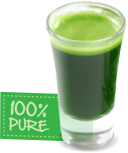Frequently Asked Questions…
Q. What exactly is Wheatgrass juice made from?
Wheatgrass Juice is made from baby wheatgrass sprouts, we grow the grass till it reached 10 to 15 cm high then carefully cut it and juice it in a slow auger, pressure type juicer so as not to harm the goodness of the juice. Wheatgrass Juice produces high concentrations of chlorophyll, active enzymes, vitamins and other nutrients (all the things we miss out on in our daily diet).
Q. How much, when and how do I drink your Wheatgrass?
Daily Maintenance: Under 40 years of age – 1 or 2 satchels per day
Daily Maintenance: Over 40 years of age – 2 to 4 satchels per day
In Crisis: Up to 10 satchels per day
- Try just one for the first time to ensure that you have no grass allergy.
- Use it throughout the day recommend 5 x 2 satchels per day
- Continue 10 pouches per day for 2 months then cut the amount in half to 5 satchels per day of 2 months, them simply drop down to daily maintenance usage suggestions as show above.
Traditionally it is taken on an empty stomach, at least 15 minutes before a meal or 2 hours after food.
Shake the pouch well, drink it straight or dilute with water or juice.
There is no limit to how much juice you can use, just guidelines that have been established over time.
Q. Why grow Wheatgrass in trays instead of soil?
By growing it in trays we can control the amount of water, light, nutrition and temperature. But if we grow it in the soil the chance of controlling the elements become a lot more difficult and also in soil the risk of diseases and bacteria
increase dramatically (e coli, salmonella).
Q. Wheatgrass juice is good for you but why does it taste so bad?
I get this question quite a lot, however if the taste is terrible it’s because there is no living enzymes in the juice, If the enzymes are alive wheatgrass juice is very sweet and palatable.
Q. Why should we supplement our diet?
If the main part of our diet is made up of processed or cooked foods, we are probably missing out on essential enzymes and sooner or later the deficiency will begin to show. Out methods of food processing can deplete or destroy, the
vital life giving enzymes: preservatives (even salt) work by inhibiting live enzymes and make foods harder to digest. Drying foods can diminish enzyme viability, irradiated and cooked foods keep well as enzymes have been
destroyed, canned and processed foods have a longer shelf life as the enzymes have been destroyed by heat, microwave heating and cooking destroys enzymes. Therefore most of our diet is void of good nutrition so we must supplement to keep us healthy. So it makes sense to supplement with natures simple and best remedy Wheatgrass Juice.
Q. What about Allergies and Sensitivities?
Wheatgrass is different from wheat. One is a grain and the other is a sprout which is a green vegetable. The green vegetable grass contains no gluten. Most allergies are due to the gluten in the grain; therefore it is no more allergenic than spinach or lettuce. Wheatgrass Juice actually contains anti allergic factors. Allergies are immune responses to toxic irritants. Detoxification is crucial to any allergy treatment program.










